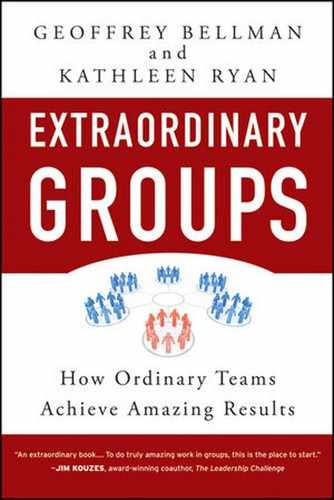During the three years on the path to completing this book, our learning has been immense! Very little of the book you hold was in the first or second draft. Our journey began with a desire to move beyond our mostly successful but less satisfying work with groups. We suspected there was something more and didn't know what it was. We loved the idea of a shared exploration, not knowing our destination. And, so far, we have reached here: One model, six needs, eight indicators, four feelings, and twenty-six suggestions. Progress? Certainly! End of story? Not a chance! We pause on this challenging, frustrating, and exhilarating journey to offer a handful of thoughts especially important to us—and perhaps to you.
Increasingly, complex problems or opportunities will require the attention of small groups because no one person has the capacity to address such issues alone. At work, in our communities, in our families, with our friends, we will continue to join in various clusters to get something done or to support each other's endeavors. Technology will further connect us in ways we cannot yet imagine and continue the reshaping of our world. The explosion of online educational programs and second-life experiences remind us of an observation from our field study—people in virtual groups have basically the same needs as those in who meet face-to-face. Those of Generation Y—those tens of millions born between 1976 and 2000—have grown up on technology and are making virtual groups even more common. These virtual connections will leap over distance, time, languages, and cultures to join us in new ways.
These twin truths are critical to all we've learned. We humans know in our bones our dependence on each other; we have known that for millennia upon millennia. We will seek out groups to belong to and bond with whether the prevailing structure wants us to or not. When we experience a group as extraordinary, we are experiencing the meeting of deep set human needs we have especially for groups.
Our ideas about small groups also apply to groups larger than twenty, but there is a point where the creative magic runs out. Let's not fool ourselves about the consequences of piling dozens or hundreds of people into one organization. It can do a lot, but it is not likely to amaze us in how it meets people's needs. No other structure besides a small group—especially no larger, hierarchical structure—is capable of consistently providing the fulfillment each of us seeks through the company of others.
Creating amazing group experiences is about meeting those core human needs of Acceptance and Potential, Bond and Purpose, Reality and Impact. When we understand these Group Needs, we can begin to act—for our own benefit and to support others. Regardless of role—member, leader, or facilitator—and armed with this insight, we can act first to help meet the needs brought by others. And then to be ready to have our own needs met as others take similar action.
We were surprised to discover early on that most people had a wonderful group experience they would love to share with us. The extraordinary was more ordinary than we had imagined! The extraordinary is not delivered, wrapped in the cover of Fortune, Fast Company, or the Harvard Business Review. It does not require graduate degrees in group process skills or leadership. It is happening around us, among regular folks who have had delightful group experiences they would like to repeat again and again. People coming from vastly different circumstances spoke to remarkably similar patterns. Each understood the special, unforgettable quality of something amazing that happened with others. And while some would just as soon leave behind their grim situations or the burnout that came from long, intense hours of work, there was not a person who didn't want to have more of the exciting and affirming interaction that characterized his or her group—that left them changed, energized, connected, and hopeful.
Early on, our friend, Tom—whom you met in Chapter Two—helped us frame this book. He said, "It's all about magic. It's about creating something really amazing at work. Every day, I do my best to help make that happen." It seems right that as we close, we return to Tom's early comment.
Why did Tom say magic? Others we interviewed used that same word. We were taken with the surprise and delight that bubbled forth in our interviews. Something unexpected happens, something that seems miraculous, in a word, magic—and people are drawn to that experience. Something transforming that happens because people have been in a group together. Thanks to all that we've learned while writing this book, the two of us are confident that those magical experiences will happen much more often when group members, leaders, and facilitators pay attention to Group Needs, feelings, and consciously chosen behaviors.
Given all the world's challenges, it would appear that we twenty-first century humans need all the transforming help we can get. And that help comes through joining with others to address our global and community complexities and meet our own very real needs to group.
So go ahead. What are you waiting for? Go out there and find a group. Take a tip from Tom and try for a little transforming magic. See what happens. We suspect you'll be glad you did.
